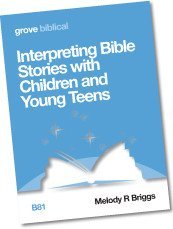 The latest Grove Biblical booklet, Interpreting Bible Stories with Children and Young Teens, is a fascinating exploration of the challenge of reading Bible stories with young people, by Melody Briggs. Melody begins by setting out the practical challenge that we might face:
The latest Grove Biblical booklet, Interpreting Bible Stories with Children and Young Teens, is a fascinating exploration of the challenge of reading Bible stories with young people, by Melody Briggs. Melody begins by setting out the practical challenge that we might face:
You are a church children’s work volunteer and it is your turn to lead the next session with your 11–12-year-old-kids’ group. You love the kids and you love the Bible. But how do you bring the two together? The topic for your session is the Luke 5.17–26 story of the healing of the paralyzed man. What do you do? The story seems at first glance to be an easy one to put across. A man is paralyzed, he has kind friends who manage to get him into Jesus’ presence despite several obstacles, Jesus heals him and—presto—he walks home praising God. But there are a few tricky spots. What role do the religious leaders play in this story? Why does Jesus first tell the paralyzed man that his sins are forgiven? Why does Jesus compare the difficulty of forgiving sins to the difficulty of healing? And what if one of your young charges notices this comparison and asks you to explain it? Better find a good commentary…
Children learn at a very early age how to make sense of stories. Like adults, the interpretive processes that they use with a story are similar to those that they use in their daily lives. Narrative is fundamental to the way that children think and they often use narrative to work out the meaning of their own worlds. Yet the interpretive strategies that children use with stories are often overlooked when the Bible and children are brought together.
Melody makes that case that we should take seriously these ‘interpretive strategies’ that children and young people are using, and does so through her research with children drawing out what they think and how they view stories. And she does so by locating this within a careful elucidation of how narrative works—but acts as a superb class in biblical interpretation for readers of any age.
Children, like adults, usually read a story because they want to know what happens. This means that their motivation for reading lies at least partially within the story itself. While what happens might be equated to the plot of the story, the development of the plot depends upon all of the story contents. The contents of a story may be divided into three basic elements: setting; characters; and plot. A narrative certainly includes other literary elements, for instance a narrator and a narratee, but the fundamental components of a story are these three basic elements.
The setting is the backdrop of a story. It orientates the reader to the story world, helping the reader to understand what the story world is like and what might be expected of the story. The setting might consist of time, location and social situation.17 It is the when, where and what of the story, although not all three of these aspects of setting need be included in a story. In the story of the healing of the paralyzed man, the time is stated at the beginning simply as ‘One day when Jesus was teaching,’ but we also know that within the context of Luke the story takes place near the beginning of Jesus’ ministry (Luke 5.17). Location is more closely specified: Jesus is in a house and there is a large crowd blocking the entrance (Luke 5.18–19). Knowing this setting is essential to understanding the events of the story. The social situation is a healing; this is stated at the beginning of the story in v 17. Also highlighted in this verse is the presence of the religious leaders who have travelled long distances to see Jesus in action. So the social situation juxtaposes the religious establishment with Jesus’ healing ministry.
The opening setting outside the house gives way to a second setting inside the house. Here the religious leaders step onto stage and the plot goes in a different direction. This brings us to the next basic element of a story, the characters. A character is an active agent who has some role in the plot. A character might be an individual or a group. In the Gospel of Luke, the crowd often functions as a group character, as do the disciples and the religious leaders. Characters might also be classified according to the type of role they play in the plot. Most stories have at least one major character who is the source of the action and is referred to as the protagonist. Protagonists are usually accompanied by secondary characters who either aid or obstruct them in some way. These secondary characters help the story along and contribute to the plot. Finally, most stories have minor characters who belong more in the background and are often passive. These minor characters usually make only one or two contributions to the plot and might show up only in one scene. Within the world of the gospels, the characters generally exist in relationship to Jesus and their role in the narrative is usually dependent upon their link to him.
A story is not static, but consists of a forward movement towards some type of resolution. The plot is the course that is run in the story and is comprised of both a series of actions and the causality that holds those actions together. It provides the story with structure. The different parts of the plot work together to create meaning so that interpreting a story must include consideration of how the plot develops. A plot often forms around some type of tension in the story world. Kingsbury describes the plot of Luke as a conflict driven by a power struggle between Jesus and his opponents. At stake is who has the right to ‘rule God’s people.’
The plot of the Luke 5 story includes the first seed of the conflict between Jesus and the religious leaders. In Luke 5.21, the Pharisees and the teachers of the Law question Jesus’ declaration of forgiveness to the paralytic. Jesus censures their thoughts in v 22 and then adds action to words when he asserts in v 24, ‘I will prove to you, then, that the Son of Man has authority on earth to forgive sins’ and heals the paralytic.
Melody integrates these elements with her research on how children read, noticing the role that these different elements play in the children’s engagement. This leads to reflection on how we should handle stories with children—and indeed how we should work with stories with all Bible readers.
What then might I do in a session on this story with a group of tweenagers? Rather than making sure that they get a certain message out of the story, I might try giving them the whole story to explore. A few methods for doing this might include drama, making a film of the story, rewriting the story in a different setting, or drawing a storyboard. I would ask, ‘How can I let the story be first and foremost a story?’ This approach would not get me off the preparation-and-planning hook. But it might well redirect my energy. I would need to immerse myself in the story in advance, so that I too have lived it. How do I imagine the setting? With which characters do I empathize? What are the implications of my empathy? When I think with the story, what values and beliefs do I find myself embracing?
Exploring the story with a group of children does not mean taking a free-for-all, anything goes approach to interpretation. It means letting the story be the primary guide to interpretation, rather than a predetermined moral or message. The story should serve as the key reference point in your responses to comments and questions.
Exploration often leads to questions, at least partially because the biblical world is not the same as our contemporary world; they differ in not only sociohistorical location, but also theological worldview. You do not need to approach your session knowing all of the answers to questions that might be raised by the story. Such an approach would turn you, rather than the story, into the source of information and would relegate the children to the role of passive learners. A better hat for you to wear would be that of a guide. The more a guide knows, the better they will be able to orientate the child explorer. Being a guide also implies active participation with the children you are guiding, so that you and the children work out together what is going on in the story world.
 That sounds like good advice for all teachers and preachers for enabling others to read well and listen to the story. This is a fascinating booklet which has wide application.
That sounds like good advice for all teachers and preachers for enabling others to read well and listen to the story. This is a fascinating booklet which has wide application.
You can order your copy of Interpreting Bible Stories with Children and Young Teens from the Grove website for only £3.95, post free in the UK.
Follow me on Twitter @psephizo. Like my page on Facebook.
Much of my work is done on a freelance basis. If you have valued this post, would you consider donating £1.20 a month to support the production of this blog?




























And that’s why we need to be spending more time storytelling the Bible too, helping people to engage with both the text, its ideas and imagery in as many ways as possible. Melody’s insights are crying out for a wider audience- thanks for highlighting this.
But how can Sunday Church do justice to this kind of thing if we always stick to using short snippets of scripture? Bear in mind that in many congregations, most adult understanding of the Bible hasn’t advanced much beyond what they learned in Sunday school…